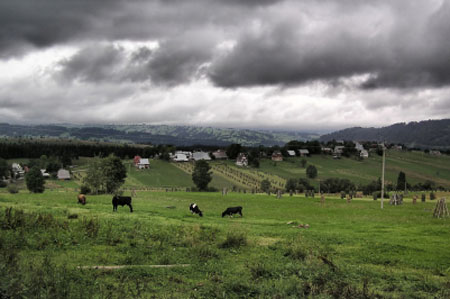Wet North America Harvest Adds Pressure For Farmers
Category: Weather
 (Reuters) – North America’s wettest harvest in about five years is hiking farmers’ costs as they dry crops to avoid spoilage and forcing them to take price discounts that are pinching incomes already under stress.
(Reuters) – North America’s wettest harvest in about five years is hiking farmers’ costs as they dry crops to avoid spoilage and forcing them to take price discounts that are pinching incomes already under stress.
One-fifth of the United States and Canadian crop belts were soaked by abnormally high precipitation during the last month, said Drew Lerner, meteorologist at commodity weather forecaster World Weather Inc. There could be more rain next week, he added, while some areas of Canada have already seen snow.
“What was in a swamp is now buried in snow,” Lerner said.
With three-quarters of U.S. corn and soybeans still in fields and some 20 percent of canola and spring wheat unharvested in Saskatchewan, Canada’s biggest wheat growing province, many farmers could face discounts for damaged crops.
Iowa farmer Adam Kleiss said it has been his most difficult harvest in a decade. Sloppy field conditions forced him to hire extra workers, including one dedicated to a standby tractor to tow trucks out of mud.
A larger payroll has halved his profits from last year. Kleiss runs a propane-fuelled grain dryer continuously to avoid spoilage of his crop and his propane costs will double to about $60,000 to dry a quarter-million bushels of corn.
“This harvest is going to be a lot more expensive,” he said.
In eastern Saskatchewan, commercial drying costs eat up 40 Canadian cents per canola bushel, or 4 percent of the C$9.75 per bushel farmers collect, said Bob Barton, who advises farmers for Agri-Trend. That works out to a cost of about C$14.50 per acre.
“That’s an added stress for these guys,” Barton said. Bank accounts remain strong from the good years, but some farmers will dip into savings or borrow to manage costs, he said.
It is still too early to gauge the full extent of damage to crop quality and yields. The areas hit so far make up about 20 percent of the crop belt in the United States, the world’s biggest corn exporter and Canada, the largest canola exporter.
The extra costs for farmers come as corn futures prices have been languishing near seven-year lows and canola remains well below peaks hit in 2012.
Worries about the impact of wet weather helped corn futures recover 8 percent since the beginning of September, while canola has tacked on 2 percent.
But farmers with damaged crops are likely to face discounts to these prices.
Doug Titus, an Indiana-based grain inspector, said fungal growth triggered by wet weather resulted in the Diplodia ear rot disease that typically reduces corn kernel weight.
Corn that weighs below benchmark levels can be discounted by as much as 5 cents per bushel at Archer Daniels Midland Co’s corn processor in Cedar Rapids, Iowa. December corn futures currently sell for about $3.40 per bushel.
Spring wheat quality in Saskatchewan, the biggest wheat-growing province, is below average, as wet conditions cause kernels to sprout and develop disease, according to the provincial government.
Much of Saskatchewan’s remaining canola crop was blanketed by snow on Wednesday, but may still be harvested, said Ian Epp, agronomy specialist with Canola Council of Canada. Standing crops may lose yield, however, if they fall over under the snow’s weight, he added.
In Manitoba, farmer Robert Brunel is optimistic he will eventually harvest his remaining 700 acres of soybeans and corn, some of which sit in standing water. But first he needs colder weather to harden muddy ground enough to drive on. If equipment gets stuck, costly breakdowns can happen.
Snow would pose another problem for his harvest of soybeans, a crop that grows low to the ground.
“That would be the end of it,” he said.

